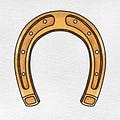It’s only 9:30, but I feel like the day has been nearly endless. After waking earlier than I would have liked and not being able to go back to sleep, I got up and started my day, following my plan of moving, working, and repeating until my brain was mush.
After a long walk, my writing focus for today was to experiment with an idea I had about adding a step to make a more complicated version of the golden shovel poetry form. I’m calling it the Horseshoe Shovel, a double shovel (as demonstrated expertly here by Patricia Smith) with the added challenge of using the shovel line as the first line of the poem as well.
I first tried it with a line I wrote to test the form. But today I tried something different, taking lines from Edna St. Vincent Millay to use as the shovel’s frame.
Here is how it works:
Write (or borrow) a first line.
Write that same line going down the left margin AND up from the bottom of the right margin. Your poem will be as long line-wise as the number of words in the first line.
Write new lines that reach from word to word.
Here is a short example using a line from Millay. It’s not a successful poem at this point, but it shows how the form works:
The Widow Moves Out House without air, I leave you and lock your door. Without him here, I cannot bear to haunt your airless rooms, tend your lawns. I fasten a lock I do not recognize, forged of steel. I test it and leave it closed, knowing that I must shutter you. You wanted me gone, creaked and insisted that I leave and take my sadness with me. I am too much. I lock you up too tight, stifle you, suck out all the air. Your emptiness restored, you’ll learn to do without. Door after door slams. No longer our home. Just a house.
One of the things I think is interesting about how the form can work is the recursive nature of the repeated words, giving this shovel form a pantoum or sestina-like quality. (I have more successful ones that I’ll keep tweaking—I wrote seven of them today—oops.) Some things I have learned about choosing a line to use as the anchor line:
Write your words out in a frame as a test before you begin. Depending on the line length, you may end up with an end/beginning transition that is awkward, like moving from “of” to “of.”
An odd number of lines will give you a center line that is “bookended” with the same word.
Try not to start with a subject pronoun or an article as this word will also be the last word of the poem.
If you are writing your own line, as with a sestina, focus on strong nouns, verbs and adjectives, especially those that can have multiple meanings or pronunciations. For instance, the most successful sample I wrote today used the Millay line “Broad field, bright flower, and the long white road.”
I would be remiss if I did not thank Jared Beloff for talking this through with me over a set of emails. I had originally continued the form to use the line a fourth time down the middle for another set of lines—I was going to call it a goal post—but he helped me see that it could be more streamlined and less convoluted as a new version of the golden shovel. (Poetry friends are great. Highly recommend.)
It was a challenging day intellectually as I also worked on the outline for a new series of poems and listened to the Of Poetry podcast episode with Emily Henry. So I treated myself this evening with the Wild and Precious Life reading on Zoom, an episode of the Great British Bake Off,and dinner out with two other residents. We’ll see what tomorrow brings.
PROMPT
Give the form a try! I’d love to see what you come up with, and if you have any hacks that you figure out, include them here in the comments!


